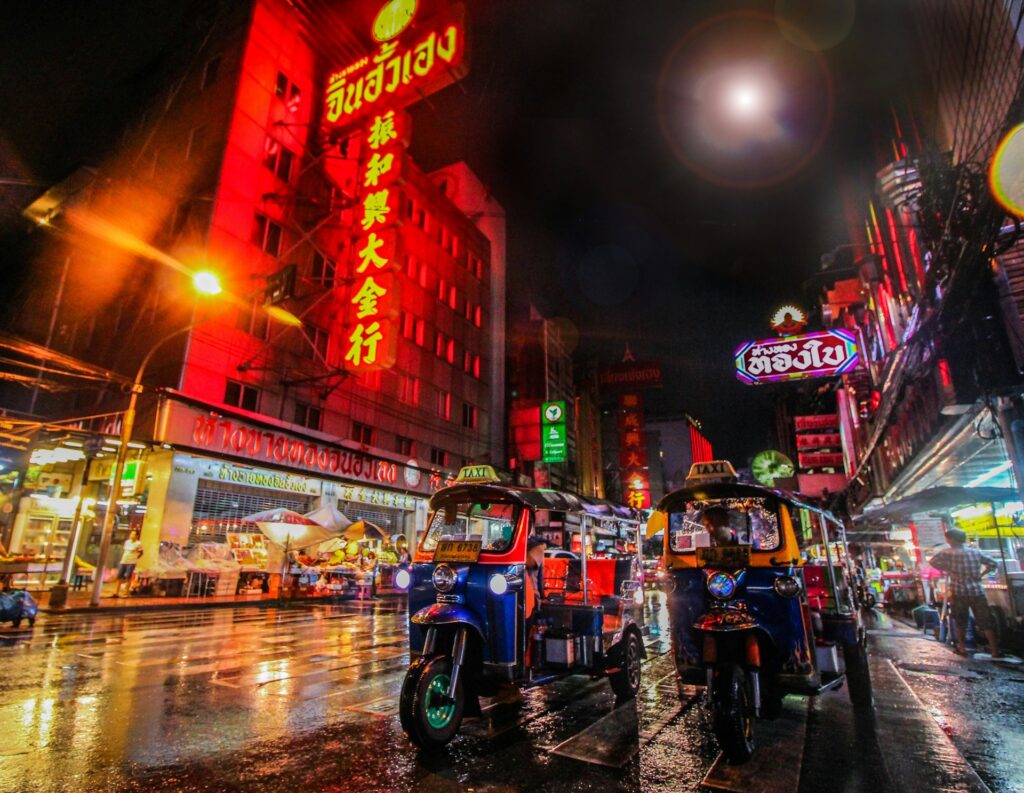Bangkok, the bustling capital of Thailand, is a city where modernity and tradition coexist in a way few other cities can match. Navigating its vibrant streets can seem daunting at first, but with the right knowledge, getting around Bangkok becomes part of the adventure. Whether you’re here for a short visit or a long stay, this guide will take you through all the ways to get around the city, from budget-friendly options to the most comfortable choices.
BTS Skytrain: Fast, Efficient, and Air-Conditioned
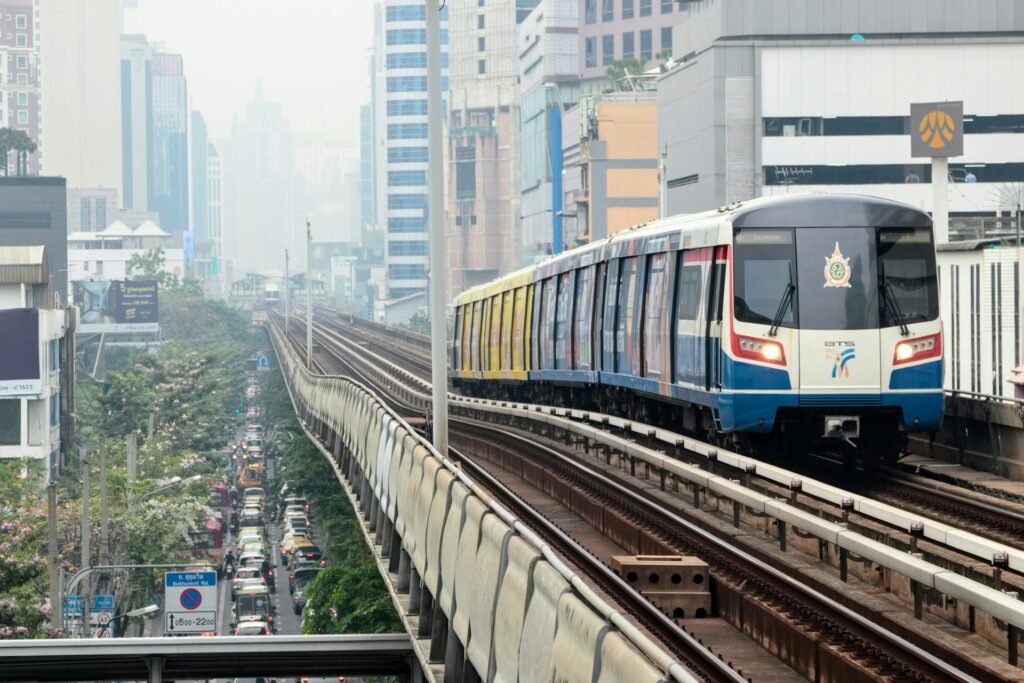
The BTS Skytrain is one of the most convenient ways to travel around Bangkok. It’s modern, reliable, and helps you avoid the city’s notorious traffic jams.
- Coverage: The BTS has two lines – the Sukhumvit Line and the Silom Line. These cover key areas, including the shopping districts of Siam, Silom, Sukhumvit, and the riverfront.
- Pricing: Fares range from 16 to 59 THB, depending on the distance. A day pass is available for 140 THB, which is a great option if you plan to hop on and off multiple times.
- Tips: Avoid rush hour (7-9 AM and 5-7 PM) unless you’re okay with standing. The stations are easy to navigate with English signage. You can simply tap your compatible credit card at the entrance and exit for contactless payment.
MRT Subway: Expanding Reach in Bangkok
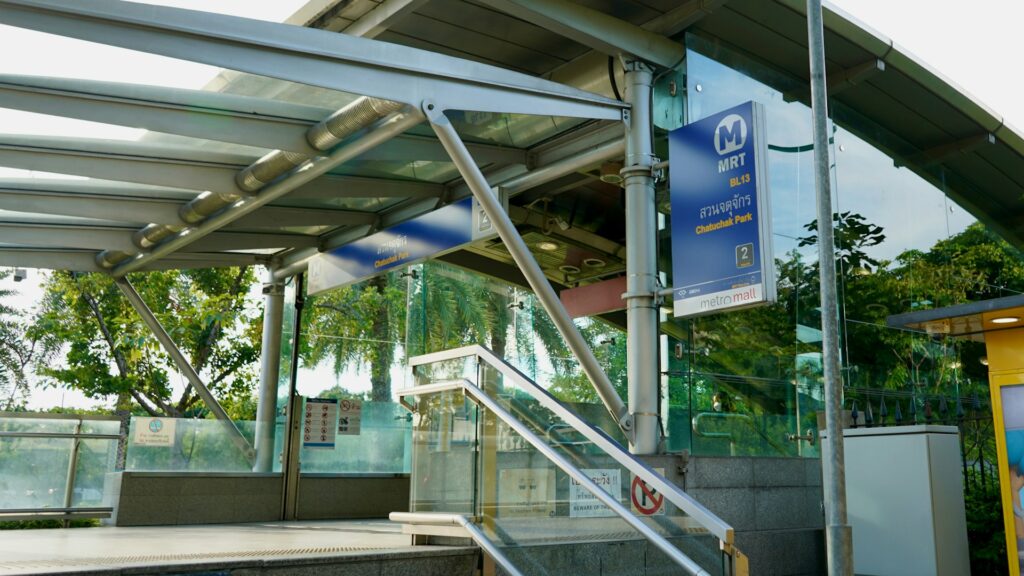
The MRT Subway complements the BTS system, covering areas not serviced by the Skytrain, such as the famous Chatuchak Market and Chinatown.
- Coverage: The MRT has two main lines – the Blue Line, which circles around key tourist spots, and the Purple Line, which services the northern outskirts.
- Pricing: Fares are similar to the BTS, ranging from 16 to 42 THB. Tickets can be purchased at vending machines.
- Tips: If you’re staying near an MRT station, it’s one of the quickest ways to get to the older parts of the city, such as the Grand Palace and Wat Pho. You can simply tap your compatible credit card at the entrance and exit for contactless payment.
Tuk-Tuks: Fun, But Be Cautious
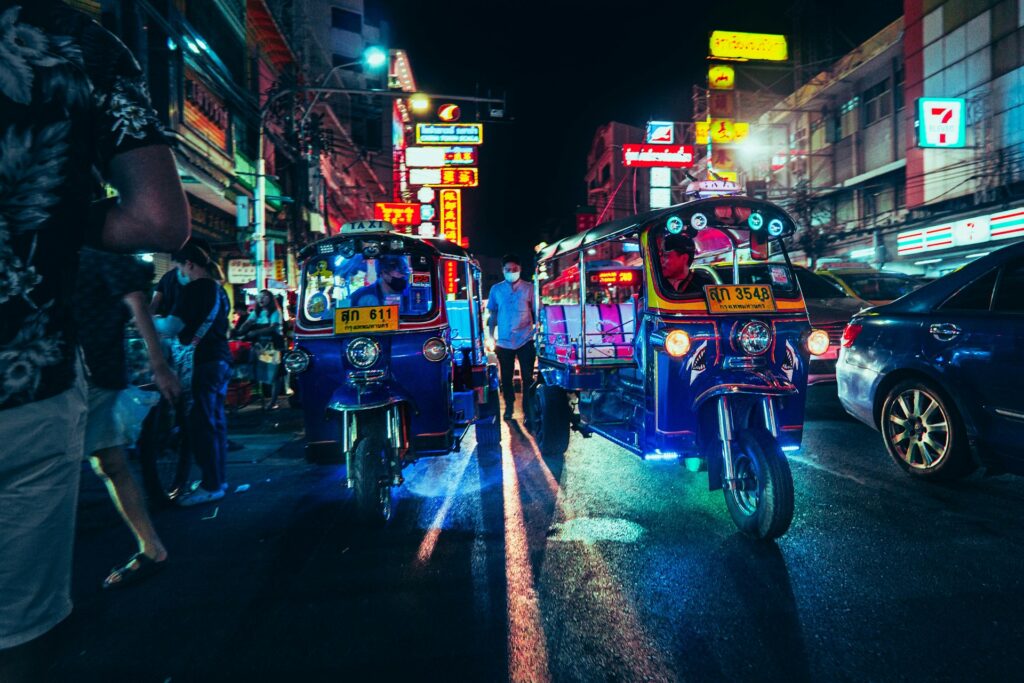
Tuk-tuks are an iconic mode of transport in Bangkok and are a fun, if not practical, way to experience the city. These three-wheeled vehicles zip through traffic but are best for short distances.
- Pricing: There’s no meter, so you’ll have to negotiate. Prices for tourists can start high, often around 150-300 THB for short trips, but always haggle. Agree on the price before the ride.
- Tips: While tuk-tuks are a novelty, they’re more expensive than taxis and don’t offer much protection from pollution or the heat. If you’re keen to try it, do so for the experience but avoid peak traffic times.
Taxis: Affordable and Air-Conditioned
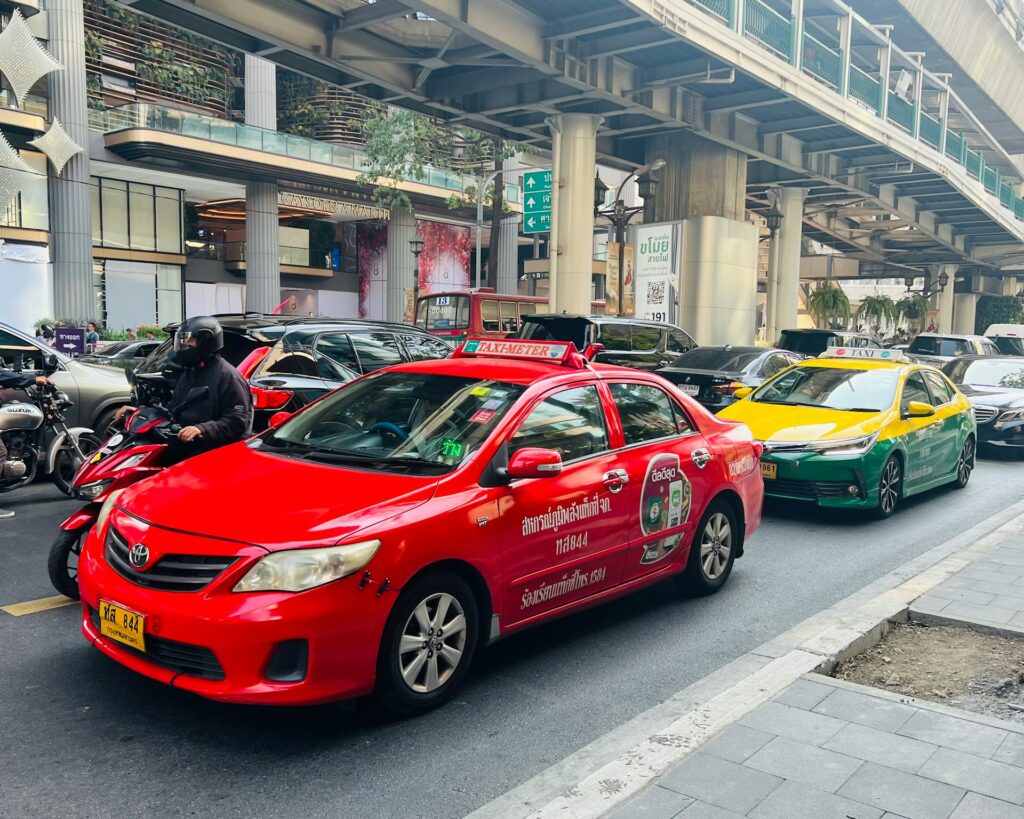
Bangkok taxis are abundant, relatively cheap, and air-conditioned, making them a comfortable option, especially if you’re traveling with luggage or in a group.
- Pricing: Taxis are metered, and fares start at 35 THB for the first kilometer. Expect to pay 100-200 THB for typical trips within central Bangkok.
- Tips: Always insist on the meter being turned on. Some drivers may try to negotiate a flat rate – refuse this politely. Apps like Grab (Asia’s version of Uber) can be a good alternative if you’re worried about communication.
Motorbike Taxis: For the Brave
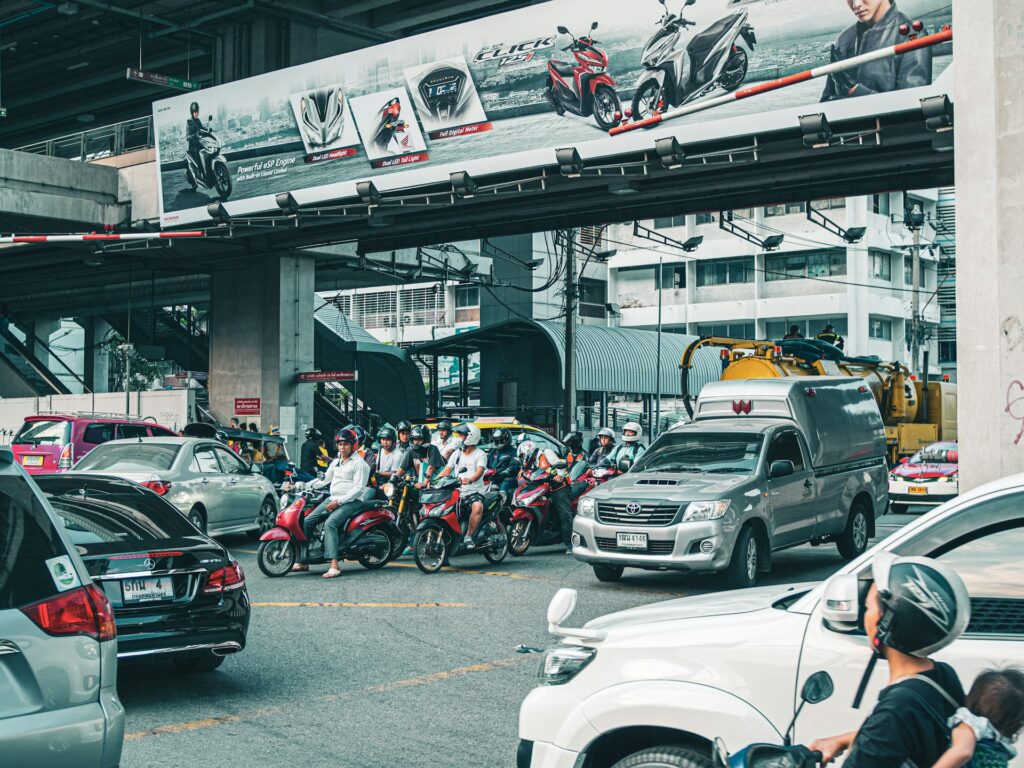
If you’re short on time and don’t mind a bit of adrenaline, motorbike taxis are a fast (though risky) way to get through Bangkok’s traffic.
- Pricing: Fares depend on the distance, typically starting at around 20 THB for a short ride.
- Tips: You’ll find motorbike taxis at designated stands with drivers wearing colorful vests. Always ask for a helmet, and hold on tight!
Chao Phraya River Boats: Scenic and Practical
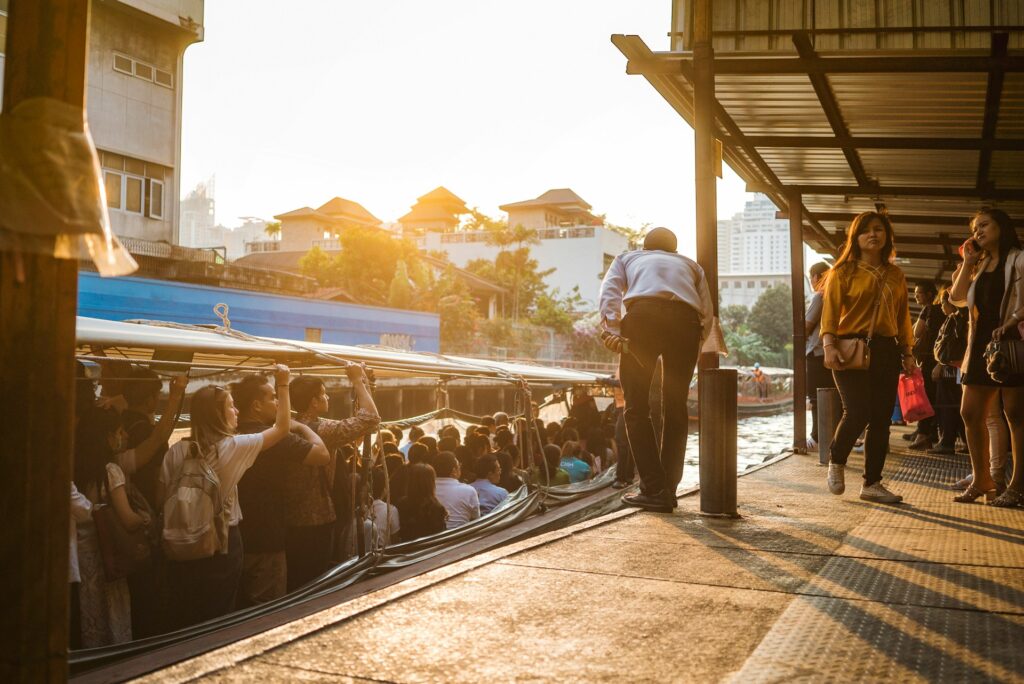
Bangkok’s Chao Phraya River cuts through the heart of the city, and taking a riverboat is a scenic way to reach some of the city’s most famous attractions, such as the Grand Palace and Wat Arun.
- Coverage: The boats run along the river with designated stops. The Orange Flag boats are the most convenient for tourists, running regularly between Wat Arun and other key destinations.
- Pricing: Prices are budget-friendly, ranging from 15 to 30 THB per trip.
- Tips: Try to catch a boat in the morning or late afternoon to avoid the midday heat. The river is a refreshing break from the city’s busy roads.
Grab and Ride-Hailing Apps: Convenient but Pricey
Grab is Southeast Asia’s answer to Uber, and it’s widely used in Bangkok. If you don’t want to deal with haggling or language barriers, this is a good option. You can also book motorbikes, cars, or even tuk-tuks through the app.
- Pricing: Prices are higher than regular taxis, but the convenience of knowing your fare upfront is worth it for some. Surge pricing can also make rides more expensive during busy times.
- Tips: If you’re in a hurry and don’t want to wait for a taxi, Grab can be a lifesaver. Just keep in mind that during rush hour, Grab vehicles also get stuck in traffic.
Buses: For the Adventurous Budget Traveler

Bangkok’s bus system is extensive but can be confusing for newcomers. However, if you’re up for a bit of adventure and want to save money, it’s one of the cheapest ways to get around.
- Pricing: Fares start as low as 8 THB for non-air-conditioned buses and go up to around 25 THB for air-conditioned ones.
- Tips: Not all buses have English signage, so it’s helpful to know the bus number and route in advance. Google Maps can be useful for navigating the bus system.
Airport Rail Link: Quick Access to Suvarnabhumi Airport
If you’re heading to or from Suvarnabhumi Airport, the Airport Rail Link (ARL) is a quick and affordable way to get to downtown Bangkok.
- Coverage: The ARL connects the airport to the BTS and MRT systems at various stations.
- Pricing: Fares range from 15 to 45 THB depending on your stop.
- Tips: The ARL can get crowded, especially during peak times, so avoid it if you have large luggage.
Walking: Explore the Local Vibes

In certain areas of Bangkok, especially around Old Town, Chinatown, and Sukhumvit, walking is an enjoyable way to soak in the local atmosphere. The city’s chaotic traffic means that sometimes walking is faster than driving!
- Tips: Be prepared for uneven pavements and the occasional need to dodge street vendors or parked motorbikes. Wear comfortable shoes and stay hydrated.
Bicycles: A Growing Trend
Bangkok is not typically known as a bike-friendly city, but there are some pockets where cycling is popular. Places like Lumpini Park or the less busy backstreets (sois) can be great for a leisurely ride.
- Bike Rentals: You can rent bicycles from specific bike shops or through hotel services in certain areas. The cost can range from 50 to 100 THB per hour.
- Tips: Be cautious when cycling on main roads as traffic can be unpredictable. Stick to quieter areas or join a guided bike tour for a safer experience.
Final Thoughts
Bangkok offers a wide range of transportation options, from the ultra-modern BTS to the traditional tuk-tuks, giving you flexibility in how you explore the city. Whether you want a fast, air-conditioned ride or prefer to soak in the sights as you travel, there’s something for everyone. Don’t be afraid to mix and match modes of transport depending on your needs – and remember, part of the fun in Bangkok is just figuring it all out!

